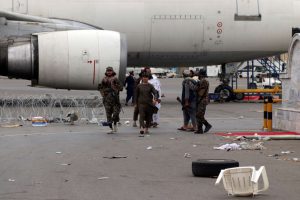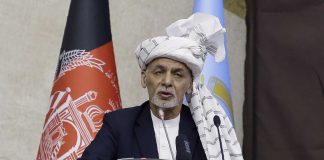SEPTEMBER 1, 2021

Taliban fighters gather at Kabul’s international airport on Tuesday after the U.S. military’s withdrawal. (Khwaja Tawfix Sediqi/Associated Press)
As the last U.S. troops exited Afghanistan, at least 50 dogs were believed to have been left behind at the international airport in Kabul, according to animal welfare and rescue groups.
The Pentagon denied that the abandoned dogs were U.S. military animals; at least one contractor was later identified as having dogs it was struggling to evacuate.
Public anger erupted after images shared online showed dozens of dogs in cages, with empty plastic water bottles strewn around and a large helicopter in the backdrop with smashed windows. Comments flew on social media accusing the U.S. government of leaving the animals in cruel conditions, while animal rights groups condemned the dogs’ abandonment.
Conservative lawmakers and commentators used the photos to excoriate the Biden administration over the withdrawal — and fueled misinformation around it.
Eric Pahon, a Defense Department spokesman, told The Washington Post that the animals pictured were under the care of Kabul Small Animal Rescue, not the U.S. military. The Pentagon said no dogs under the direct care of the U.S. military were left in cages at the Kabul airport.
“To correct erroneous reports, the U.S. military did not leave any dogs in cages at Hamid Karzai International Airport, to include the reported ‘military working dogs,’ ” Pahon said in a statement. “Despite an ongoing complicated and dangerous retrograde mission, U.S. forces went to great lengths to assist the Kabul Small Animal Rescue as much as possible.”
The priority mission, he said, was evacuating people such as U.S. citizens, holders of special immigrant visas and “vulnerable Afghans.”
GardaWorld, a military contractor, confirmed to the Military Times on Tuesday that it had dogs in Kabul but did not specify how many. It said it would work with Kabul Small Animal Rescue to continue evacuation efforts despite “grueling” setbacks.
“Our team has worked relentlessly with numerous dedicated charities to rescue our dogs and all the animals under KSAR’s care,” GardaWorld said in a statement to the Military Times.
Jason Johnson, who founded Project K-9 Hero, a U.S. charity that supports retired military working dogs, told The Post on Tuesday that military personnel and U.S. contractors in communication with his group were aware of about 50 contractor-owned animals left behind and an additional 150 or so that were a mix of pets belonging to American expats and stray animals from Kabul that KSAR had rescued and intended to send to new homes abroad.
Laura Sheehan, a spokesperson for the group American Humane, which has collaborated with the U.S. military on animal aid and relief efforts since World War I, had similar reports from the group’s military contacts before Monday’s evacuation.
“As far as we’ve been told, there were about 50 contract-working dogs left,” Sheehan told The Post. “Those animals would be contracted to the U.S. military to provide support,” working security, patrol and explosive detection, she said.
Sheehan added, “Given the status of the contractor dogs, the U.S. government doesn’t view those animals as its responsibility.”
It was not immediately clear why the dogs were left behind or which of the various military contractors owned the dogs. The condition of the dogs is also unknown, Johnson said. “We have no confirmation those dogs are still in crates and still alive,” he said.
Thousands of Afghan and American service members and expats scrambled to flee Afghanistan after the Taliban completed its swift takeover of the country in mid-August. But evacuations became more challenging — and perilous — in the small segment of the airport that U.S. forces still controlled as President Biden’s Aug. 31 withdrawal deadline approached.
Johnson, who served as a dog handler in the Defense Department, where he worked for the U.S. ambassador to Afghanistan in 2009, expressed confidence in the Pentagon’s statement. The strength of the bond between U.S. military service animals and their handlers made him skeptical that handlers would abandon their partners.
“They’d be more likely to stay behind than leave without them,” Johnson said. “Dogs in Project K-9 Hero served in Afghanistan [and] saved the lives of many Marines. I don’t think we can underestimate that.”
Johnson said he was aware that other animal rescue groups are raising funds to coordinate evacuations for the remaining animals, but he expressed little confidence that those missions could succeed now that the Taliban has taken over the airport and no U.S. forces remain.
“I don’t see how you can negotiate with the Taliban,” he said.
Johnson said it would be the responsibility of the contractors and their employees to create a plan for the dogs, but he said logistics of the situation were unknown, including whether the dogs had been required for service up to the final hours of the U.S. presence at the airport.
The Society for the Prevention of Cruelty to Animals International (SPCAI) said Charlotte Maxwell-Jones, the founder of Kabul Small Animal Rescue, was forced to leave the airport grounds on Monday, stymieing efforts to evacuate the animals.
Maxwell-Jones described in a message to The Post Wednesday being kicked out of the airport by U.S. forces and then taken home by Taliban fights. “A really weird day,” she wrote. She noted that U.S. soldiers were “very kind to the dogs, helped me care for then and clean them.”
“The soldier who escorted me out was polite and sympathetic, just following orders,” she said.
She described charter flights sent to evacuate the animals being unable to land due a mangle of “bureaucratic reasons,” including overland flying rights, landing permits and the red-alert security level at the airport.
“Charlotte was informed that most of the KSAR dogs had to be released into the airport on August 30 as the airport was evacuated — turning once-rescued shelter dogs into homeless strays,” the SPCAI said in its statement.
Maxwell-Jones notes that the dogs were never “abandoned,” but rather “seized from me and released.”
After photos of the stranded canines sparked anger on social media, many people offered to take them in, questioned how they could have been abandoned and recounted their own experiences with dogs in conflict zones.
Other animals have been caught up in the Afghan withdrawal, with a British marine, Paul “Pen” Farthing, making global headlines as he tried to leave the country with dozens of rescue cats and dogs in an evacuation mission dubbed “Operation Ark.” Farthing landed in Britain on Sunday, but he has faced criticism for evacuating without the charity’s human staff.
Biden said in an address Tuesday that an estimated 100 to 200 Americans remain in Afghanistan. He characterized them as mostly dual citizens who are longtime Afghanistan residents and have not left because of family connections.
“That was the choice, the real choice — between leaving and escalating,” Biden said. “I was not going to extend this forever war, and I was not extending a forever exit.”

































































































